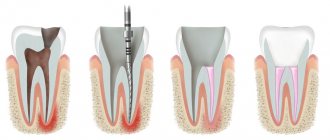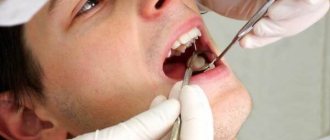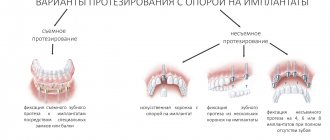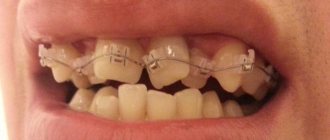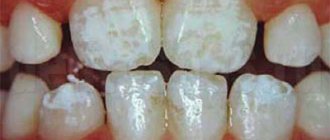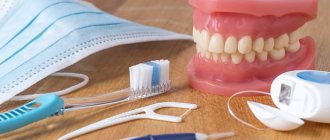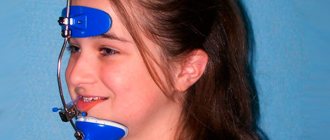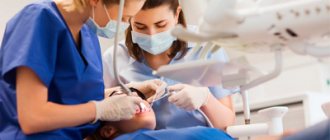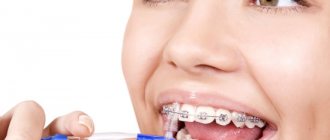Reflex severity
The gag reflex manifests itself in different ways. It is better to choose remedies to help cope with it depending on the severity.
Mild degree
It usually does not cause serious problems during dental treatment. You can deal with it using the following methods:
- When the gag reflex is psychological in nature, the dentist can simply distract the patient. To reduce your stress levels, you can refocus your attention the night before your doctor's visit.
- If the gag reflex is caused by touching the mucous membranes, the doctor protects them with a rubber dam. This is a latex sheet that the dentist uses to cover the mucous membrane. This way it protects it from contact with foreign objects. The rubber dam also allows you to isolate soft tissue from the diseased tooth, providing additional protection.
- Anesthesia. Anesthetic drugs help not only relieve pain in the mouth. They have a freezing effect, the mucous membrane becomes less sensitive.
Average degree
It is very important here to reassure the patient and reduce his anxiety. Regular local anesthesia will not have the desired effect, since it only numbs the pain. Using general anesthesia in such cases is not always justified.
Sedation helps cope well with the problem of fear and nausea. The patient is given nitrous oxide to inhale through a mask. He falls into a relaxed state, but is fully conscious. This is the advantage of sedation over anesthesia, since the contact between the dentist and the patient is completely preserved.
Severe degree
It is not always possible to cope with nausea to such an extent with conventional sedatives. Such cases are an indication for the use of general anesthesia.
“The problem of the gag reflex in patients when planning treatment in orthopedic dentistry.”
Muradyan Rafael Mkhitarovich
Student, Department of Orthopedic Dentistry and Orthodontics, Cheboksary
Tsyganov Valery Petrovich
Assistant at the Department of Orthopedic Dentistry and Orthodontics
FSBEI HE “Chuvash State University named after. I.N. Ulyanov"
Annotation.
This article highlights the problem of the gag reflex in dental patients, its causes and ways to eliminate it.
The gag reflex is a natural reaction of the human body that prevents foreign objects from entering the respiratory tract.
The pathogenesis of an increased gag reflex is poorly understood and is multifactorial; there are several hypotheses for its occurrence during a dental appointment.
To eliminate the increased gag reflex, medicinal and physiological (distraction) methods have been proposed when taking impressions in the dental chair.
Introduction
Currently, many orthopedic dentists are faced with the problem of increased gag reflex in patients when performing various dental procedures. This problem causes much greater inconvenience to the patients themselves, especially those who require total orthopedic work in the oral cavity. An increased gag reflex can manifest itself at various stages of dental diagnostics, starting from taking impressions of the prosthetic bed, ending with a banal examination of even the frontal group of teeth.
Main part.
The gag reflex is a protective reflex that allows the body to get rid of the cause that caused irritation; in the human body it is carried out when the vomiting center located in the medulla oblongata is excited. An understanding of this phenomenon can only be obtained through a psychophysiological analysis of the perceptogenesis of the oral cavity as a zone of border interaction of interoceptive, proprioceptive and exteroceptive sensitivity, forming nonspecific reflex ensembles of the visceral and cortical parts of the brain in ontogenesis.[1]
There are two types of reactions that cause the gag reflex:
● Physiological – response to mechanical impact, touch in the mouth;
● Psychological – reactions associated with dental phobia;
Therefore, before starting dental procedures, it is necessary to collect a thorough medical history and identify the presence of a gag reflex. You should understand the reason for this reaction and take all possible options to eliminate the reflex.
It is important to create a favorable psycho-emotional background when communicating with the patient; he should feel comfortable throughout the entire appointment. Of no small importance is the psychological impact on the patient by instilling in him the idea of the safety of this manipulation; a firm, decisive explanation and preliminary repeated careful insertion of the impression tray into the oral cavity, allowing for the extinction of the gag reflex. It is necessary to help the patient take the most comfortable position in the chair; the patient’s head is given a vertical position and firmly fixed in the headrest.
As for eliminating physiological causes, the following measures need to be taken:
- 1. Give the patient recommendations with which he can independently eliminate his problem. For example, do not eat 2-3 hours before visiting the dentist; make an appointment in the afternoon (it has been established that the sensitivity of the reflex is increased in the morning); methodically train the reflex day after day by placing the toothbrush in the mouth, moving it from the front group of teeth closer to the soft palate.
- 2. When taking impressions, it is important to note that in order to reduce the irritating effect, the impression material should be taken in a minimal amount and, while taking an impression, it should be vigorously and firmly pressed against the mucous membrane of the distal part of the prosthetic field from the very beginning.
- 3. It is necessary to accurately select the impression tray, it is inappropriate to use an impression tray that is not the right size, the insertion of the impression tray should be carried out quickly and at the same time try not to touch the back of the tongue; Light “tickling” touches to the mucous membrane should be avoided, as this increases nausea.
- 4. Follow the technique of taking impressions: in a sitting position, the chin should be pressed, the patient should look the doctor in the eyes and breathe deeply through the nose.
- 5. With a thorough history taking, without identifying contraindications, you can use medications (for example, Cerucal, Dramina, Motilium, Folimite).
Conclusion.
Thus, if patients have a significant problem that manifests itself as an increased gag reflex at a dental appointment, it is necessary to identify its origin. Most often, this reaction is a manifestation of dental phobia, which is most often eliminated with the help of simple manipulations and a competent individual approach from the dentist to the patient. It is permissible to correct irritation of receptors in the oral cavity with the help of local anesthetics, in the absence of contraindications.
Bibliography:
1. Yu.I.Klimashin. On the nature of the phenomenon of increased gag reflex in the practice of orthopedic dentistry // Stomport.2012.
2. V.N. Trezubov, A.S. Shcherbakov, L.M. Mishnev “Orthopedic dentistry. Propaedeutics and the basics of a private course." Moscow. 2011.
3. Yumashev A.V., Mikhailova M.V., Kuderova I.G., Kristal E.A., Doroshina I.R. Orthopedic treatment of patients with an increased gag reflex // Dentistry for everyone. – 2014. – No. 4. – P. 18-20.
What can a doctor do to reduce the gag reflex?
- Lidocaine. The drug is used for local anesthesia. Lidocaine sprays or gels are usually used.
- Local anesthesia of the palate. This method is used on the upper jaw.
- Conduction anesthesia of the lower jaw. After the administration of the anesthetic, the patient’s cheeks, gums, tongue, and lower lip become numb. Their sensitivity decreases, the doctor is able to carry out therapeutic manipulations normally.
During dental treatment, salivation often increases. Saliva gets onto the root of the tongue, and this increases nausea. To ensure patient comfort, the dentist removes saliva using a saliva ejector. If the reflex is pronounced, you can change the patient’s position and treat him while sitting. This way, less saliva reaches the root of the tongue.
Not only therapeutic procedures, but also diagnostic procedures and impressions before prosthetics or restoration can cause nausea. Here, a lot depends on the methods and equipment used in the clinic.
The 32 Dent clinic uses a new intraoral scanner, Medit 500. It allows you to make a 3D model of your teeth. For the patient, this method offers many advantages compared to traditional impressions:
- Scanning comfort. No powder is needed when using the Medit 500 intraoral scanner. The entire scanning procedure takes place quickly and continuously. The device has a small nozzle, which also reduces the risk that the patient will experience nausea during insertion of a foreign object into the oral cavity.
- High accuracy of results. The Medit 500 intraoral scanner allows you to obtain high-resolution images with minimal error. Thanks to this, the doctor is able to accurately assess the condition of the oral cavity and not carry out additional diagnostic procedures.
- High speed. The image obtained during scanning is immediately displayed on the monitor. In order to obtain a 3D model of the oral cavity, approximately 2 minutes are enough - about a minute for one jaw. Even if the patient has a strong gag reflex, in most cases, attacks of nausea do not occur in such a short period.
- Possibility to interrupt scanning and start it from the desired point. The Medit 500 intraoral scanner is turned on and off with a button. If the patient feels nausea or vomiting. The doctor can take a break and continue the scan from where he left off.
The use of modern intraoral scanners helps our doctors make not only treatment, but also diagnostic procedures comfortable.
What can a patient do to reduce the gag reflex?
If you know that you have a pronounced gag reflex, you can prepare for your visit to the dentist in advance. For this you can use medications:
- 4-5 days before visiting the dentist you can take Cerucal and Motilium. In the first days, take half a tablet, and the day before your appointment, take a whole tablet.
- Cerucal can be taken without other medications. In this case, we recommend taking 1 tablet three times a day the day before your appointment, and on the day of visiting the dentist, take one tablet.
- Any medications for motion sickness.
- The night before and on the day of the visit, you can take two Adaptol tablets.
All of these drugs can effectively combat nausea. Usually, if the attacks are caused by fear, it is enough to take medications before 2-3 appointments with the doctor. After this, in most cases, the strong gag reflex that interferes with normal dental treatment goes away.
When nausea is not severe, you can do without pills:
Before dental treatment, it is better not to eat or drink for two hours.
Since nausea is caused by impaired nasal breathing, instill drops that relieve nasal congestion. It is better to do this right before starting treatment.
Rinsing your mouth with soda, salt, mint or eucalyptus-flavored solutions helps to cope with strong salivation.
If you start feeling sick during dental treatment, try to switch your attention. Sometimes shaking your leg is enough to do this. You can block vomiting by breathing. To do this, you need to inhale through your nose and exhale through your mouth.
The dentist must be warned that you have a pronounced gag reflex. This will help the doctor choose the best method to solve the problem. It is often enough to simply reassure the patient or book him in for the second half of the day, since by this time the gag reflex is reduced.
Universal tips for patients with a gag reflex
- Avoid eating food two to three hours before visiting the dental clinic;
- It is preferable to choose the afternoon to visit the dental clinic, when the severity of the reflex is reduced.
- Full, unobstructed nasal breathing will significantly reduce the likelihood of a reflex occurring. At the slightest approach of the reflex, you need to focus on rhythmic breathing through the nose and exhaling through the mouth. Consult your doctor about the advisability of taking vasoconstrictors or solutions for rinsing the nasal passages.
- Try to train the reflex: daily practicing the presence of objects (a toothbrush, a teaspoon) in your mouth more and more deeply. In many cases, the reflex can be tamed in just a couple of weeks.
- During dental procedures, try to switch problem areas, for example, by sharply clenching your fingers into a fist or raising your leg.
- Sometimes rinsing your mouth with salted water or simply sprinkling a few grains of salt on the tip of your tongue before a dental procedure can be effective.
- Find contact with your doctor. Ask him all the questions that worry and worry you. Tell him about your previous treatment experience, when the reflex appeared, and what causes it. In the Moscow dental clinics “Tavi” and “Veronica”, where an individual approach to each patient is practiced, you will definitely find your doctor, whose treatment will not only be effective, but also comfortable, even in such a rather unusual situation.
Be healthy!
Posted in Useful information

